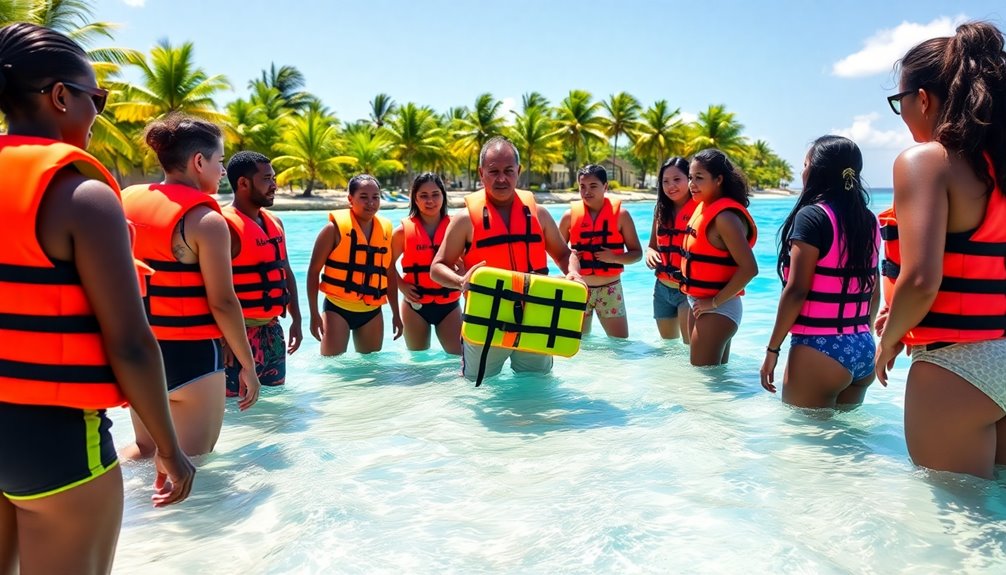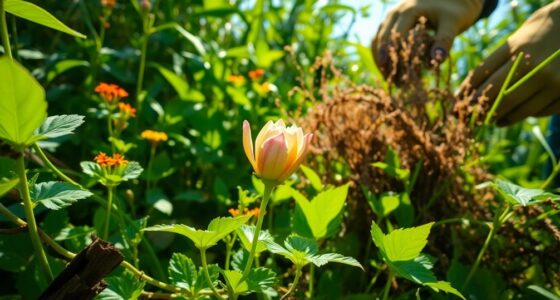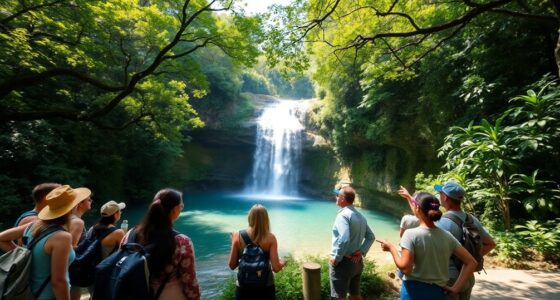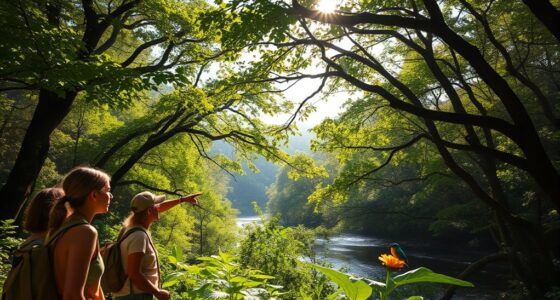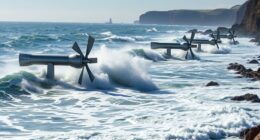To ensure water safety in Pacific Islands, you need to adopt new tactics like infiltration galleries for effective groundwater management. These systems can help mitigate saltwater intrusion and extract fresh water from shallow depths. It's also important to implement Water Safety Planning (WSP) while building local governance. Enhancing community capacity through training and collaborative approaches will strengthen resilience. As you explore further, you'll discover additional strategies to safeguard vital water resources.
Key Takeaways
- Implement infiltration galleries to extract groundwater safely and reduce seawater contamination risks on atoll islands.
- Develop localized Water Safety Plans (WSP) tailored to community governance systems for effective water management.
- Enhance community capacity through training programs focused on risk-based water management and resource allocation.
- Foster collaborative approaches to strengthen community resilience against climate change impacts on water safety.
- Increase investments in technical and financial resources to support rural areas in managing drinking water services effectively.
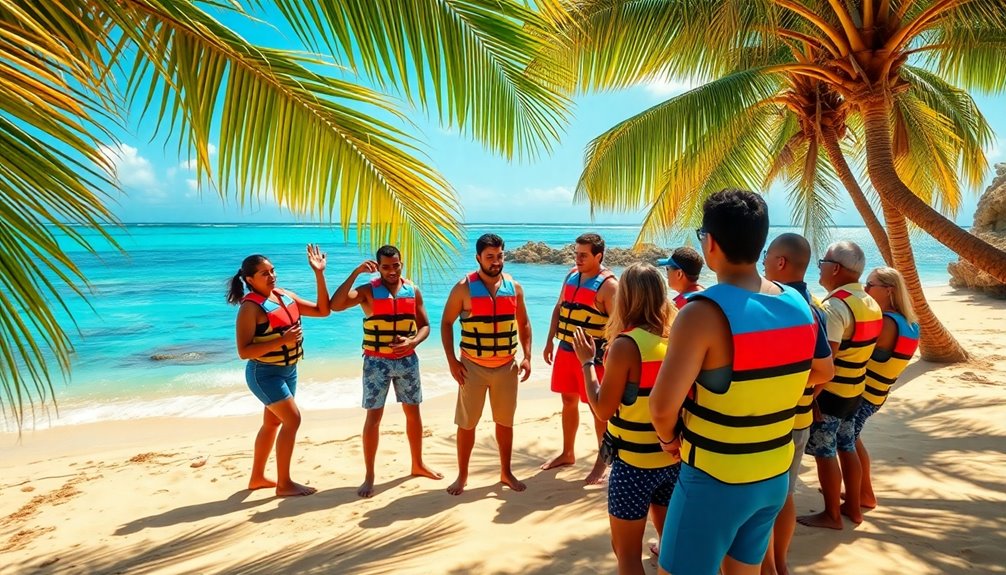
As climate change and urbanization threaten water resources in Pacific Island Countries (PICs), ensuring access to safe drinking water becomes more urgent than ever. You mightn't realize that about 3 million people in the Oceania region lack this basic necessity. The geography of these islands, combined with rising sea levels and increasing pollution, complicates the availability and quality of water.
Unfortunately, saltwater intrusion into freshwater sources poses a significant risk, especially as urbanization intensifies demand on already limited supplies. To combat these challenges, groundwater management strategies, such as infiltration galleries, have emerged as viable solutions. These systems extract fresh groundwater from shallow depths on atoll islands, minimizing the risk of seawater contamination. Infiltration galleries are crucial for extracting fresh groundwater and can help address the urgent need for sustainable water sources in these vulnerable regions.
However, designing these galleries requires careful consideration. You should be aware that comprehensive data on their performance is lacking, indicating a need for further research. Effective management of groundwater resources can help sustain water supplies, particularly in remote communities.
Implementing Water Safety Planning (WSP) is another crucial step. This risk-based approach, recommended by the World Health Organization, ensures safe drinking water. In Fiji and Vanuatu, WSP efforts often fall short, highlighting the need for additional resources and localized modifications to fit community governance systems.
Meanwhile, the Solomon Islands still lack formal adoption of this strategy, underscoring a critical gap in water safety. Climate change exacerbates these issues, making your community more vulnerable to water-borne diseases as extreme weather events and rising temperatures strain resources.
Rural areas face unique challenges in managing drinking water services, often lacking the technical and financial resources necessary for effective WSP implementation. Enhancing community capacity for risk-based water management is essential to tackle these challenges head-on.
Frequently Asked Questions
What Are Common Water Safety Risks in Pacific Islands?
In Pacific Islands, common water safety risks include contamination from inadequate waste disposal and sanitation facilities, leading to diarrhoeal diseases.
You'll also face challenges like limited access to clean water, especially in rural areas, where only about 55% of the population has basic drinking water.
Additionally, rising sea levels and extreme weather threaten freshwater supplies, while socioeconomic disparities further complicate access to safe water for many communities.
How Can Local Communities Participate in Water Safety Initiatives?
Imagine your community gathering around a fire, sharing stories of water safety.
To participate in water safety initiatives, you can join local committees, attend training sessions, and help identify risks.
Engage in hands-on projects like building rainwater catchments or plumbing systems.
Organize community events to raise awareness and share resources.
By working together and involving youth, you'll strengthen your community's commitment to ensuring safe water for everyone.
Your actions make a real difference!
What Are Effective Educational Methods for Water Safety Awareness?
To effectively raise water safety awareness, use interactive storytelling to engage children and make lessons memorable.
Incorporate play activities and role-playing for practical understanding. Visual aids like safety charts and props can enhance learning.
Structured curricula and community workshops provide comprehensive education.
Don't forget the importance of swimming lessons and CPR training.
Are There Specific Regulations for Water Activities in Pacific Islands?
You won't believe the intricate web of regulations governing water activities in the Pacific Islands!
There are mandatory guidelines for whale and dolphin watching that prioritize safety and marine life protection. Many areas fall under customary marine tenure, allowing local communities to manage access.
Enforcement frameworks ensure compliance, while ongoing scientific monitoring informs policy. Community involvement is crucial too, fostering sustainable practices and enhancing local ownership over these precious waters.
How Can Technology Enhance Water Safety Measures in Remote Areas?
Technology can significantly enhance water safety measures in remote areas by utilizing innovations like solar pumps for energy independence and UV disinfection systems for effective pathogen removal.
You can leverage drone technology for efficient water sampling and real-time monitoring with in situ sensors.
Additionally, digital management applications allow you to manage water resources effectively, ensuring quality and accessibility, while community engagement ensures these technologies are accepted and sustainable for long-term use.
Conclusion
In the vast embrace of the Pacific, safety's gentle caress is more vital than ever. By weaving innovative tactics into our daily lives, we can ensure that our waters remain a sanctuary, not a perilous playground. Let's nurture a culture where vigilance dances hand-in-hand with joy, transforming the waves into a harmonious lullaby rather than a tempest. Together, we can craft a future where every splash is a celebration, inviting laughter and peace to our shores.
